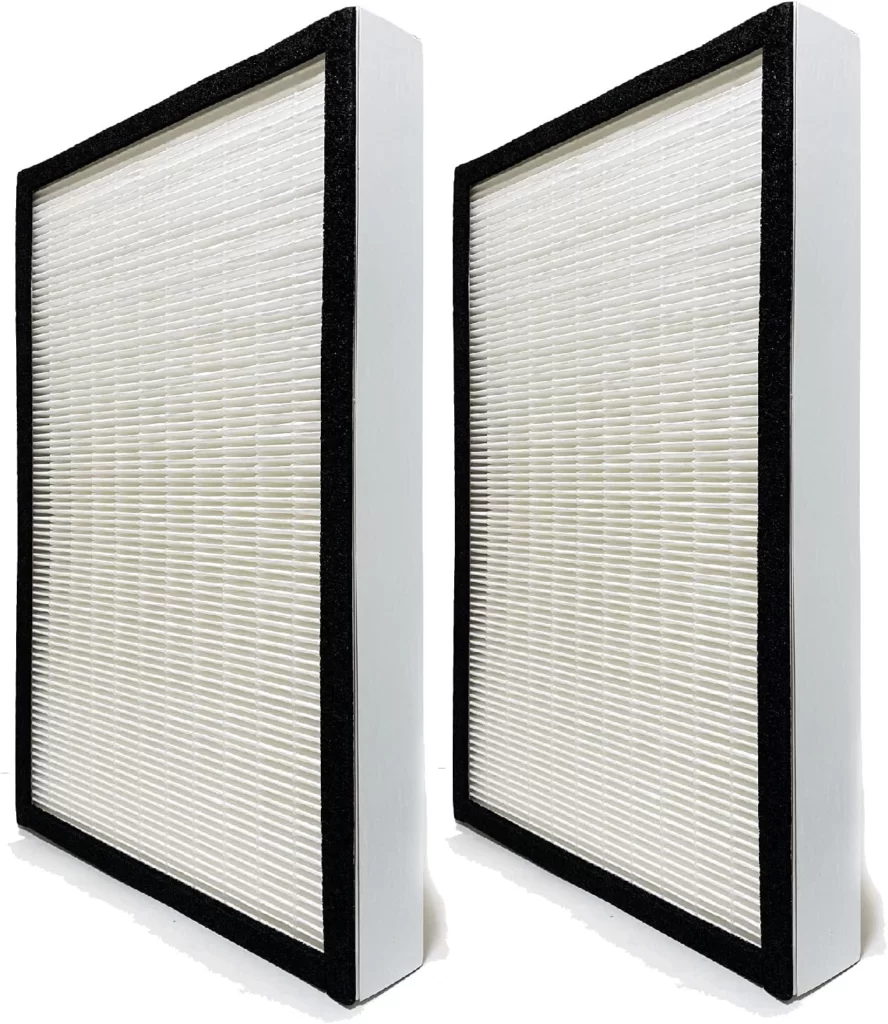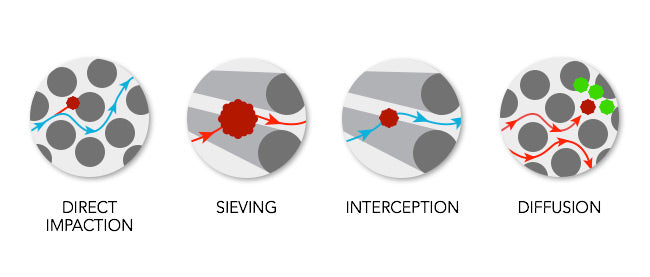When shopping for an air purifier to remove dust and other particulates from your room, you’ll likely encounter options with either a HEPA Filter or a True HEPA Filter. These are currently the primary methods used to capture airborne particles.
However, an average buyer might wonder if there’s any significant difference between the two, considering the only apparent distinction is the term “True” preceding one of them. Does it really matter that much?
What is a True HEPA Filter

HEPA stands for High Efficiency Particulate Air and refers to a type of filter that can trap a large amount of very small particles that other vacuum cleaners would simply recirculate back into the air of your home.
HEPA filters are standardized and must meet specific requirements set by the U.S. Department of Energy (DOE). To qualify as a True HEPA filter under U.S. government standards, a filter must remove 99.97% of particles from the air that pass through it, and these particles must be 0.3 microns in size. This is known as the MPPS (Most Penetrating Particle Size), which is the hardest size of particle to filter. Particles larger or smaller than 0.3 microns are filtered with even higher efficiency.
Filters that do not meet these criteria are often marketed as “HEPA-like”, “HEPA-type”, or “99% HEPA” to distinguish them from true HEPA filters. These other filters do not offer the same level of filtration as true HEPA filters and can vary widely in effectiveness. These types of filters can be misleading because while they might sound like they provide similar performance, they do not meet the stringent criteria to be classified as a True HEPA filter.
So, if you’re looking for the gold standard in air filtration for allergens, fine dust, and other airborne particulates, a True HEPA filter is what to aim for.
Working of HEPA filter
HEPA filters work in a fascinating way! They’re typically made from a complex network of intertwined glass fibers that form a maze-like structure. As particles attempt to navigate through this maze, they get trapped in different ways:

Direct Impaction: Imagine larger particles like certain dust, mold, and pollen types trying to move in a straight line. They bump into a fiber and get stuck there, just like a car hitting a roadblock!
Sieving: Sometimes, the air flow carries a particle between two fibers. However, if the particle is bigger than the gap, it gets trapped, just like a big fish caught in a net!
Interception: Picture how air can flow around fibers, but particles, due to their inertia, keep going and stick to the fiber sides. It’s like a runner who keeps going straight when the road turns!
Diffusion: Small, super tiny particles move more chaotically than bigger ones, making them more likely to bump into and stick to fibers. This is like a pinball bouncing around and hitting various targets!
In Easy words
- The air purifier uses fans to pull in the air. This air is full of different particles – big, small, all sizes.
- First, the air meets a helper called a pre-filter. The pre-filter is like a big, strong net that catches larger particles. This is important because it helps keep the HEPA filter from getting clogged up with big stuff.
- Next, the air moves through the HEPA filter. This is where the magic happens! The HEPA filter is a master at trapping tiny particles. Once caught, these particles will never return to your air.
- Some companies say a slightly dirty HEPA filter might trap particles even better, but it’s also important to know that these filters need to be replaced regularly, at least once a year.
- After passing through the HEPA filter, the air is now mostly free of particles. It might move on to another helper, like a carbon filter. This filter is like a bad-odor magnet!
The carbon filter can be positioned before or after the HEPA filter. While there isn’t a definitive answer on the best placement, it seems logical that clean, particle-free air would work best for the carbon filter. it’s better to understand the difference between Carbon filter and Hepa filter for you to select right air purifier.
True HEPA Filter vs. HEPA Filter
When comparing a “True HEPA Filter” and a “HEPA Filter”, the difference is much bigger than you might think. Think of it like this:
A “True HEPA Filter” in an air purifier is like a super detective. It’s guaranteed to catch 99.97% of tiny invaders in the air, even as small as 0.3 microns. Microns are super tiny, way smaller than a speck of dust! So when you see “True HEPA Filter” on the label, you know it’s really good at its job.
On the other hand, an air purifier with just a “HEPA Filter” is like a detective who might not give you all the details. It might say it catches 99.9% or even 99.97% of invaders, but it doesn’t tell you how small they can be. It’s like saying, “I’ll catch all the bad guys,” but not telling you if it can catch the really sneaky, tiny ones.
Sometimes, companies use this to make their purifiers seem like they’re as good as the ones with the “True HEPA Filter”, even though they might not be able to catch the smallest particles. And even if they say their purifier can catch larger particles, like 2 microns, it’s not as good as catching those teeny tiny 0.3 ones. It’s a bit like saying you’ll catch all the bad guys, but only the big ones, not the little sneaky ones.
So when you’re choosing an air purifier, it’s better to pick the one with the “True HEPA Filter”. You know exactly what it can do, and it’s really good at its job.
About Official HEPA certification
The term “HEPA” comes from a standard established by the U.S Department of Energy (DOE). This standard was initially created during the 1940s’ Manhattan Project when the DOE needed filters capable of filtering out radioactive particles during atomic testing. However, the standard doesn’t specify how the filter should be built or what materials it should be made from—only that it should be capable of trapping a specific number of particles.
Importantly, there’s no official consumer-level HEPA certification program. The standard mainly ensures proper air filtration in government and military projects. For example, government contractors must adhere to strict standards when installing HEPA filters in nuclear facilities’ ventilation systems and demonstrate that these filters meet the DOE’s HEPA standard.
While some non-government industrial facilities, such as hospitals’ protected environments and clean rooms, need HEPA filtration systems, three organizations publish testing protocols to verify that a filter captures the required 99.97% of 0.3 micron particles.
What to look for when Buying True Hepa Filter air purifier
When shopping for air purifiers, the label “True HEPA” or “Absolute HEPA” is what you want to see. It means the filter should meet a high standard. But remember, there’s no official test for this, so you might also want to look for a UL certification mark to be sure.
Stay away from unclear terms like “HEPA-type” or “HEPA-like”, as these might not meet the high standard. Always look for clear numbers like: “99.97 percent of all particles at 0.3 microns in size.”
Be wary of any other fancy claims. Really good filters that perform better than the standard HEPA are usually found in industrial settings and can be expensive.
There are a few other things you should know:
- “CADR” stands for “clean air delivery rate”. It’s a measure of how fast an air purifier can clean the air, but it doesn’t tell you how it performs over time or with different pollutants.
- Some air purifiers say they remove particles “down to” a certain size. But without knowing what percentage of these tiny particles it catches, this claim doesn’t mean much.
- “Carbon” or “activated carbon” are terms you might see. These are good for removing gases and odors, but they are separate from the HEPA filter. They don’t tell you if the filter meets the HEPA standard.
Remember, if it says “HEPA” on the label, it doesn’t automatically mean it’s a good filter. Look for “True HEPA”, a UL mark, or check the details yourself. If you’re still unsure, it might be safer to stick with well-known brands.
Source of Information : EPA
FAQ
Can I clean and reuse my True HEPA filter, or should I replace it?
Most True HEPA filters are not designed to be cleaned and reused. Once they’re saturated with particles, they should be replaced. Always check the manufacturer’s instructions.
What particle size can a True HEPA filter capture?
True HEPA filters can capture particles as small as 0.3 microns in size.
How often should I replace my True HEPA filter?
This largely depends on your usage and air quality, but generally, True HEPA filters should be replaced every 12 to 18 months.
Can a True HEPA filter remove allergens and pet dander from the air?
Yes, True HEPA filters are effective at removing allergens and pet dander, which are typically larger than 0.3 microns.
Is a True HEPA filter capable of removing smoke particles and odor?
While it can capture smoke particles, a True HEPA filter alone may not fully eliminate smoke odor. Air purifiers with activated carbon filters are more effective for odor removal.
Will a True HEPA filter remove mold spores from my indoor air?
Yes, True HEPA filters are capable of capturing mold spores, which are typically 1 to 5 microns in size.
Can viruses and bacteria be captured by a True HEPA filter?
True HEPA filters can capture many bacteria and some viruses, though efficiency may vary as some viral particles can be smaller than 0.3 microns.
How do I know if my air purifier uses a True HEPA filter or a regular HEPA filter?
Look for ‘True HEPA’ on the label. If it isn’t there, it might not meet the DOE’s strict standards.